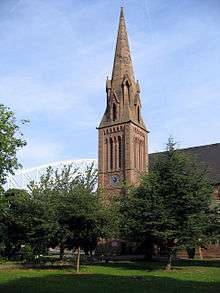Runcorn
| Runcorn | |
|---|---|
| Town | |
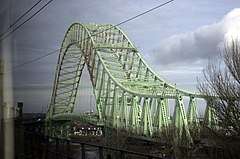 Runcorn's Silver Jubilee Bridge | |
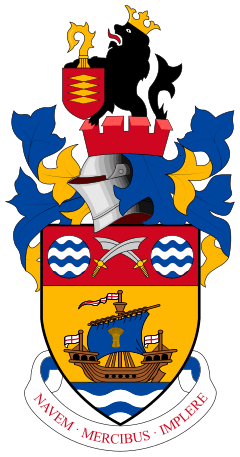 Coat of arms of Runcorn | |
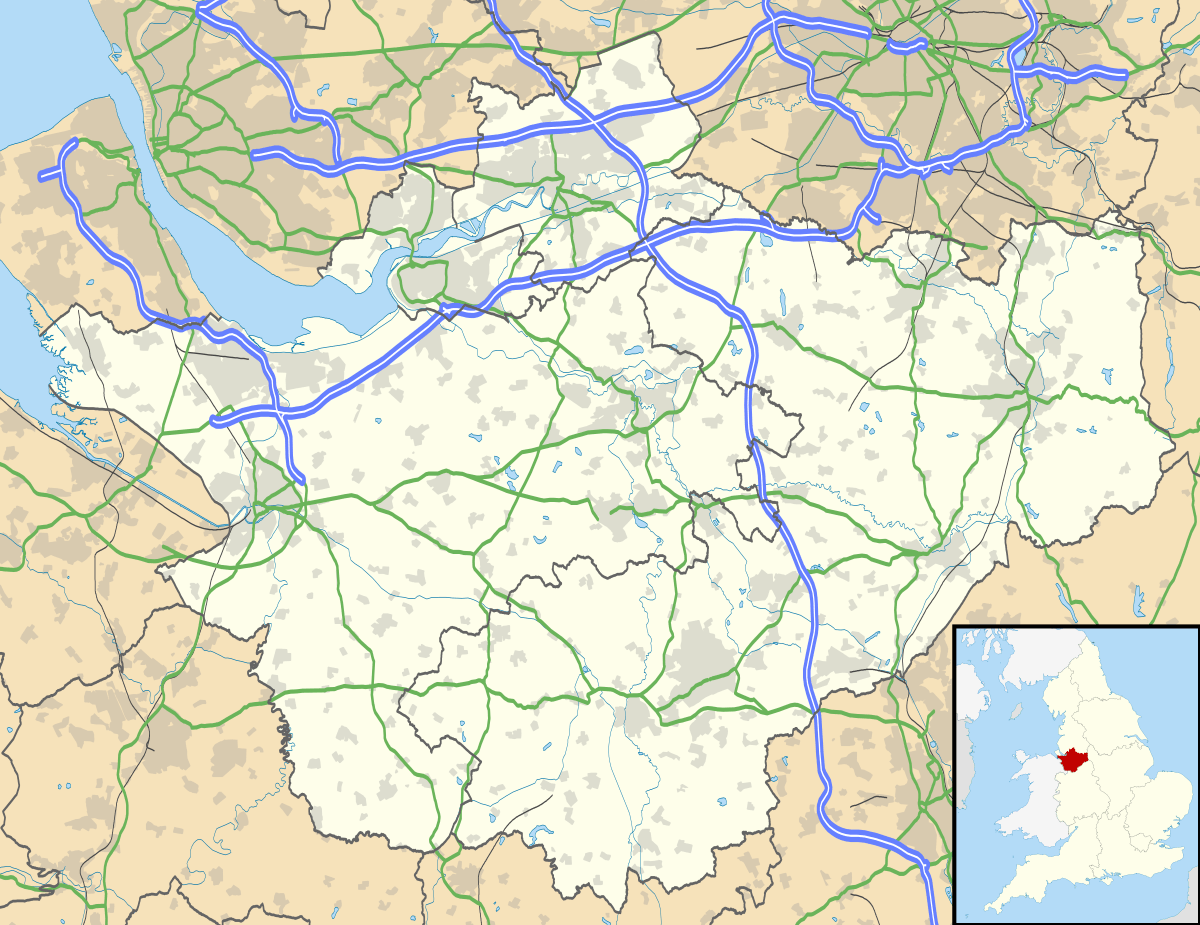 Runcorn Runcorn shown within Cheshire | |
| Population | 61,789 [1] |
| Demonym | Runcornian |
| OS grid reference | SJ525815 |
| • London | 167 mi (269 km)[2] SE |
| Unitary authority | |
| Ceremonial county | |
| Region | |
| Country | England |
| Sovereign state | United Kingdom |
| Post town | RUNCORN |
| Postcode district | WA7 |
| Dialling code | 01928 |
| Police | Cheshire |
| Fire | Cheshire |
| Ambulance | North West |
| EU Parliament | North West England |
| UK Parliament | |
Runcorn is an industrial town and cargo port in Halton, Cheshire, England, and in the southeast of the Liverpool City Region. Its population in 2011 was 61,789.[1] The town is on the southern bank of the River Mersey, where the estuary narrows to form the Runcorn Gap. Directly to the north across the River Mersey is the town of Widnes. Upstream and 8 miles (12.9 km) to the northeast is the town of Warrington, and downstream 16 miles (26 km) to the northwest is the city of Liverpool.
Runcorn railway station is on a branch of the West Coast Main Line and provides frequent services to Liverpool Lime Street, Birmingham New Street and London Euston. Runcorn East connects Manchester Piccadilly, Warrington Bank Quay, Chester and North Wales. The A533 road passes through the town from the south and over the Mersey Gateway Bridge across the River Mersey and the Manchester Ship Canal. The M56 motorway passes south of the town, through Preston Brook. Three bridges span the River Mersey and the Manchester Ship Canal at Runcorn: the Silver Jubilee Bridge, Mersey Gateway and Runcorn Railway Bridge. The Bridgewater Canal terminates in the town centre.
Runcorn was a small, isolated village until the Industrial Revolution. It was a health resort in the late 18th and early 19th centuries. Towards the end of the 18th century, a port began to develop on the south bank of the River Mersey. During the 19th century, industries developed around the manufacture of soap and alkali, quarrying, shipbuilding, engineering, and tanning. New York Harbour and Liverpool Cathedral were built with Runcorn sandstone quarried from what is now Runcorn Hill Park.[3] By the early 20th century, the prime industries were chemicals and tanning.
Chemical and high tech manufacturing continue and there has been diversification into services and particularly logistics because of Runcorn's easy access to the Manchester Ship Canal, railway and motorway networks. Runcorn was designated a new town in 1964 and greatly expanded eastward in the 1960s and 1970s.[4] Areas of housing have continued to expand farther to the east with the development of Sandymoor in the 1990s and 2000s. This rapid growth since the second half of the 20th century has resulted in the population more than doubling from around 26,000 to its present estimated level of 70,000.
The town's motto is Navem Mercibus Implere meaning 'fill the ship with goods'. It is a classical quotation from Juvenal.[5]
History
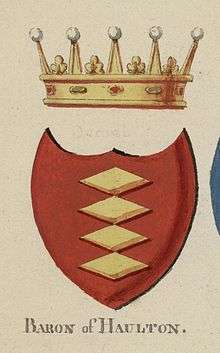
Early history
The earliest written reference to the town is in the Anglo-Saxon Chronicle, where it is spelled "Rumcofan", literally meaning "a wide cove or bay". This word is derived from the Old English words "rúm" ("wide" or "broad") and "cofa" ("cave" or "cove"). Other historical spellings of Runcorn include "Rumcoven", "Ronchestorn", "Runckhorne", and "Runcorne".[6]
Little is known about the early history of the settlement but isolated findings of objects from the Stone, Bronze, and Iron Ages have been made and there is evidence of a Roman presence in the area.[7]
The earliest recorded event in its history is the building by Ethelfleda of a fortification at Runcorn to protect the northern frontier of her kingdom of Mercia against the Vikings in 915. The fort was built on Castle Rock overlooking the River Mersey at Runcorn Gap.[8]
Medieval
Following the Norman conquest, Runcorn was not mentioned in the 1086 Domesday survey, although surrounding settlements were. William the Conqueror granted the earldom of Chester to Hugh d'Avranches who granted the barony of Halton to Nigel. It is likely that Nigel erected a motte and bailey castle on Halton Hill in the 1070s.[9]
In 1115, Nigel's son, William Fitznigel, founded an Augustinian Priory at Runcorn. In 1134 the priory was moved to Norton, about 3.5 miles (6 km) away. In 1391 the priory was raised to the higher status of abbey.[10] In 1536 the monastery was dissolved, and around nine years later the buildings and some of the monastic lands were sold to Sir Richard Brooke who converted the habitable part of the abbey into a house.[11]
In 1565, Rocksavage, an Elizabethan Hall, was constructed for Sir John Savage in Clifton, now part of Runcorn.[12]
17th century
During the Civil War, Halton Castle was held for the Royalists by John Savage, 2nd Earl Rivers, the Steward of Halton. It fell twice to Parliamentarian Roundheads.
The first siege was led by Sir William Brereton in 1643; the second was during the following year. Following this, a "Council of War" was held in Warrington in 1646 at which it was decided that the castle should be slighted.[13]
In 1656, Runcorn was described as being "nothing but a fair parish church, a parsonage and a few scattered tenements".[14] And so it remained for over a century, an isolated and poor hamlet. The only through traffic used the ferry which crossed from Runcorn to the north bank of the River Mersey.
18th century
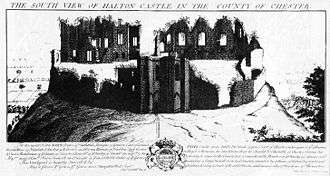
During the 18th century water transport had been improved in the area by the Mersey and Irwell Navigation, the Bridgewater Canal and the Trent and Mersey Canal. This gave Runcorn waterway connections with most of the interior of England through the canal system and with the sea along the River Mersey, thus forming the basis for the development of the Port of Runcorn.[15]
Later came the Runcorn to Latchford Canal linking with the Mersey and Irwell Navigation, and the Weston Canal which gave better access to the Weaver Navigation system.[16]
Industries began to develop within and around the town, in particular quarrying for Runcorn sandstone, shipbuilding, engineering, the manufacture of soap and chemicals, and tanning. Towards the end of the 18th century and in the early years of the 19th century, the town was a health resort.[17]
19th century
.jpg)
The growth of industry by the early 19th century had not diminished Runcorn's reputation as a health resort and in 1822 the town's first Saltwater Baths opened. This was followed by new visitor accommodation in 1831 at Belvedere Terrace "for the reception of visitors in search of health and pleasure".[4]
In the middle of the century, the growing wealth of the town and its industrialists saw the construction of several new landmarks, including Halton Grange, St Paul's Methodist Chapel and All Saints' Church.[18]
For hundreds of years, the only means of crossing the River Mersey had been by the Runcorn ferry. Thomas Telford proposed a 1,000 feet (300 m) single span suspension bridge as early as 1817, but it was not until 1868 that the first bridge, Runcorn Railway Bridge, was opened across the Mersey at Runcorn. This gave the town direct rail links with Liverpool and the rest of the country.[19]
Runcorn was becoming an industrialised and highly polluted town. During the later 19th century the town became increasingly dominated by the chemical and tanning industries. In the 1880s a pipeline was opened between Northwich and Weston Point, supplying brine to the salt works and in 1896 the Castner Kellner chemical works was established.[20]
In 1894 the Manchester Ship Canal was opened throughout its length.[21] This allowed ocean-going ships to travel inland as far as Salford, some of them calling at the port of Runcorn. The rise in population between 1881 and 1891 and the drop by 1901 is explained by the number of people involved in constructing the ship canal.
20th century
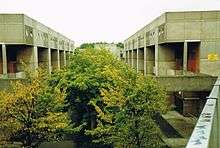
In 1905, the Widnes-Runcorn Transporter Bridge opened, giving a direct link for vehicular traffic for the first time between the two towns.[22] This would not be replaced until 1961 with the construction of Runcorn Road Bridge (since renamed the Silver Jubilee Bridge) which allowed a more efficient means of road traffic across Runcorn Gap.
During the first half of the 20th century, the industry of the town continued to be dominated by chemicals and tanning. This growth was largely due to government fixed-priced cost contracts for tanned hides. In 1926, four chemical companies merged to form Imperial Chemical Industries (ICI).
During the second half of the 20th century, the tanneries closed (the last to close was the Highfield Tannery in the late 1960s) and the chemical industry declined. At the same time, light industry developed together with warehouses and distribution centres.[23]
| Year | 1901 | 1911 | 1921 | 1931 | 1941 | 1951 | 1961 | ||||||
|---|---|---|---|---|---|---|---|---|---|---|---|---|---|
| Population | 16,491 | 17,353 | 18,476 | 18,127 | 21,718 | 23,931 | 26,035 | ||||||
| Source:[24] | |||||||||||||
The designation of Runcorn as a new town in 1964 brought major changes and more than doubled the population. Much of the architecture of the new town was innovative, especially the Southgate development designed by Sir James Stirling and built between 1970 and 1977. Stirling's housing development was beset with problems and it was demolished in the early 1990s.[25]
Governance
Local government
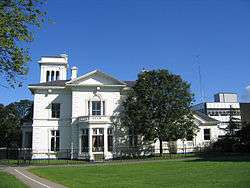
At the time of the Domesday survey, Runcorn was in the hundred of Tunendune,[26] but later, and until the early 19th century, Runcorn was part of the Bucklow hundred.[27]
Under the Runcorn Improvement Act 1852, a board of Improvement Commissioners was established to administer the civil government of the town.[28] By the Local Government Act 1894, the administration of the town and the surrounding areas was divided into Runcorn Urban District and Runcorn Rural District. Initially the urban district consisted of only the built-up area of Runcorn itself. By 1937, this area had been extended to include the communities of Weston and Weston Point to the south. In 1964, Runcorn was designated as a New Town and greatly expanded so that by 1971 it had grown to incorporate the village of Halton.[29]
In 1974, as part of the Local Government Act 1972, Runcorn Urban District was abolished and its territory amalgamated with Widnes to form the Borough of Halton under Halton Borough Council and Cheshire County Council. In 1998, Halton Borough Council became a unitary authority within the ceremonial county of Cheshire.[30] In April 2014, Halton Borough Council joined five other local authorities in Merseyside to form the Liverpool City Region.
The town is divided into ten electoral wards,[31] with councillors serving for up to four years.[32]
Westminster representation
Before the Reform Act 1832, Runcorn was in the parliamentary constituency of Cheshire which was represented by two Members of Parliament.[33] Following the Reform Act, the town was placed in the North Cheshire constituency and from 1868 in the Mid Cheshire constituency. From 1885 to 1950 the town was in the constituency of Northwich.[34] By an act of Parliament in 1948, the constituency of Runcorn was created, and in 1950 Runcorn's first Member of Parliament, Dennis Vosper, was elected.[35] He continued to represent the constituency until 1964, when he was succeeded by Mark Carlisle.[36]
In 1983, the constituency of Runcorn was abolished. The western part of the town, which includes the old town area and part of the new town, is in the constituency of Halton and the eastern part, containing the rest of the new town and private housing to the east of this, is in the Weaver Vale constituency. Since the 1997 general election the Member of Parliament for the Halton constituency has been Derek Twigg of the Labour party.[37] Weaver Vale, on the other hand, is a marginal seat and has switched parties several times.
Geography
Location
.png)
Runcorn is situated on a spur projecting into the River Mersey, which flows to the north and then to the west of the town. On the north bank of the river is another spur forming the West Bank area of Widnes; together these form Runcorn Gap, a narrowing of the River Mersey. Runcorn Gap is crossed by three bridges: Runcorn Railway Bridge (which carries the Liverpool branch of the West Coast Main Line), the Silver Jubilee Bridge and the Mersey Gateway which carries the A533.
To the south of the town is the River Weaver and the Weston Canal. Both open into the Manchester Ship Canal.
To the southeast of the town runs the M56 motorway, the Chester–Manchester railway line, and the main branch of the West Coast Main Line.
The town has a system of "expressways", roads designed to divert traffic away from the residential areas, which form a figure of 8 around the town.[38] The Central Expressway runs through the centre of the town in a north-south direction and is the main through-road.
To the west of the Central Expressway lie most of the former settlements which formed the older part of the town, namely Runcorn, Higher Runcorn, Weston, Weston Point and Clifton (formerly Rocksavage), and the new town areas of Halton Brook and Halton Lodge.
To the east are the village of Halton, the old settlements of Norton and Stockham, and the new town areas of Castlefields, Palacefields, Windmill Hill, Murdishaw, Brookvale, Hallwood Park and Sandymoor.[39]
The density of housing is generally high, but there are open green areas, in particular heathland on Runcorn Hill and the extensive Town Park created as part of the new town.
Industry is typically situated on the outside of the expressways. Chemical factories are concentrated mainly to the southwest of the town bordering the Mersey, while newer industries are to the northeast and southeast.[23]
Geology

The Runcorn area drains into the River Mersey to the north and the River Weaver to the south.
The bedrock of the western and northeastern parts of the town is made up of rock from the Sherwood sandstone group; in the other areas the bedrock is from the Mercia mudstone group.
In places there are prominent outcrops of sandstone, particularly at Runcorn Hill and Halton Hill. Elsewhere the bedrock is covered by drift.
At the northwestern periphery of the town the drift consists of recently blown sand. Farther to the east and bordering the River Mersey is recent alluvium. Elsewhere the drift consists of till.[40]
Demography
Population growth
Since the borough of Halton became a unitary authority in 1998, demographic trends have been collated for the authority as a whole, rather than separately for the towns of Runcorn and Widnes. While the two towns have different histories and come from different historic counties, their demographic features are similar.
The population of Halton in 2011 was 125,700.[41] The change in population during the 20th and 21st centuries is shown in the following table.
| Year | 1901 | 1911 | 1921 | 1931 | 1941 | 1951 | 1961 | 1971 | 1981 | 1991 | 2001 | 2011 | |
|---|---|---|---|---|---|---|---|---|---|---|---|---|---|
| Population | 57,755 | 57,062 | 61,039 | 65,309 | 71,835 | 79,026 | 87,168 | 96,150 | 121,861 | 124,915 | 118,215 | 125,700 | |
| Source:[42][43] | |||||||||||||
Religion
The 2011 census showed, that of the people living in Runcorn, 70.1% declared themselves to be Christian, significantly higher than the national average in England of 59.4%. 23.5% stated that they had "no religion," and 5.5% made no religious claims. Those stating their religions as Buddhist, Hindu, Jewish, Islam or Sikh amounted to 0.8%.[1][44]
The Anglican churches are part of the Diocese of Chester and the Deanery of Frodsham.[45][46] The parish church is All Saints in the old town centre. Ten other Anglican churches are in the town.[46]
Five Roman Catholic churches can be found in Runcorn and are administered by the Diocese of Shrewsbury.[47]
There are three Methodist chapels and one Welsh Presbyterian chapel.[46]
There are also several shared churches. Wicksten Drive Christian Centre is shared between the Church of England and the Methodists. Hallwood Ecumenical Parish in Beechwood and Palace Fields consists of 3 churches all recognised by the Church of England, the Methodists and the United Reformed Church. Norton Ecumenical Parish, covering Windmill Hill, Norton and Murdishaw, is served by an Ecumenical Partnership between St Berteline's Church (Anglican) and Murdishaw Ecumenical Church (Methodist run).[46]
There is an Independent Baptist chapel, three independent Christian churches, and an LDS Church. The Jehovah's Witnesses have two Kingdom Halls with three congregations, and there is a Spiritualist church.[46]
In 2013 the former Waterloo Hotel was converted into a Buddhist temple by Wat Phra Singh UK. As of May 2014, there are five resident monks.[48]
Ethnicity
In the 2011 census, of Runcorn's 61,789 residents, 97.8% were White, with 96.3% identifying as White British. Mixed/multiple ethnic groups made up 1.2%, Asian/Asian British 0.7%, Black/African/Caribbean/Black British 0.2%, and Other/Arab 0.1%. 98.5% had English as a first language.[1]
Economy

Many of Runcorn's 19th century industries have ceased, but it remains a major centre for chemicals, logistics and advanced manufacturing. Services have also become a major employer.
There are five main areas of industry in the town: Astmoor Industrial Estate in the north; Manor Park in the northeast; Sci-Tech Daresbury to the southeast; Whitehouse Industrial Estate to the south; and the Heath Business Park, extensive chemical plants and the town's two ports in the west. The main shopping area is at Runcorn Shopping City in the centre of the town and there are restaurants and shops in the old town.
Chemical industry
The industry was dominated for many years by ICI's Chlor Chemical division; since divested and taken over by Ineos.[49] In Runcorn, Ineos manufactures chemicals including chlorine, chlorine-containing compounds including vinyl chloride, heavy chemicals including alkalis, and fluorine-containing compounds. A separate business within the same company manufactures salt from brine transported by pipeline from the saltfields of central Cheshire.[50] The former ICI offices and laboratories now comprise the Heath Business and Technical Park, which provides office, laboratory, conference, and leisure facilities.[51]
Advanced manufacturing and research
Sci-Tech Daresbury is a National Science and Innovation Campus located on the south eastern edge of Runcorn. The campus offers lab space, offices and workshops to rent. It is home to the largest supercomputer in Europe and the Virtual Engineering Centre which works with Bentley motor cars, BAE Systems and Jaguar Land Rover. The same site also houses Daresbury Laboratory which employs over 300 staff specialising in accelerator science, bio-medicine, physics, chemistry, materials, engineering and computational science.[52]
Manor Park business estate houses several high tech engineering firms, including Sigmatex which manufactures carbon fibre for Formula 1 racing cars, naval vessels, aircraft and communication satellites. Héroux-Devtek, a manufacturer of landing gear for the commercial and military aviation industry, also has a site on Manor Park.
Runcorn is also host to many conventional manufacturing firms, primarily on Astmoor Industrial Estate in the north and Whitehouse Industrial Estate in the south.
Logistics
To the east of the town, diverse industries have been developed including, because of the proximity to the motorway system, warehouses and distribution centres.[23] The town continues to act as a port on the Manchester Ship Canal. There are two adjacent ports. Runcorn Docks is owned by the Manchester Ship Canal Company, which is part of the Peel Ports Group.[53] The Port of Weston is owned by the Stobart Group.[54][55] In March 2014 the UK's largest incinerator for burning refuse-derived fuel, managed by Viridor, commenced operation in Weston Point.[56]
Services
There has been a shift in employment from manufacturing to service industries. In 1991, 34% worked in the manufacturing sector and 61% were in the service sector. By 2004 17% were in manufacturing jobs and 78% were in service jobs.[57] This trend in the local region is demonstrated in this chart which shows the regional "gross value added" of Halton and Warrington at current basic prices, with figures in millions of pounds.[58]
| Year | Regional Gross Value Addedd | Agriculturea | Industryb | Servicesc |
|---|---|---|---|---|
| 1995 | 3,636 | 14 | 1,361 | 2,261 |
| 2000 | 4,768 | 10 | 1,433 | 3,324 |
| 2003 | 5,774 | 18 | 1,399 | 4,356 |
- ^ includes hunting and forestry
- ^ includes energy and construction
- ^ includes financial intermediation services indirectly measured
- ^ Components may not sum to totals due to rounding
Runcorn has two shopping centres. The original shopping area was in the older part of the town on High Street, Regent Street and Church Street.[59] This centre continues to exist, but with the coming of the new town, has declined. In the centre of the new town, Runcorn Shopping City is an enclosed shopping mall with two attached bus stations.[60] Adjacent to it is Trident Retail Park containing shopping outlets and a cinema and nearby is a large Asda superstore that opened in 1989.
Landmarks and places of interest
Halton Castle
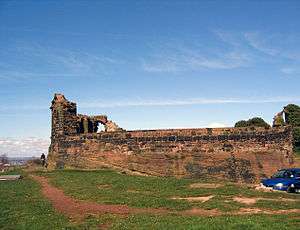
The major landmark in the town is Halton Castle on the top of Halton Hill near the geographical centre of the town. Only ruins of the castle exist, but there are widespread views from the top of the hill. The castle grounds are open at advertised times.[61] Incorporated in the castle walls is the Castle Hotel building, which used to include a courthouse on the first floor.
Norton Priory
An important historical site and the major visitor centre in the town is Norton Priory, now a museum. The site contains the remains of a priory with adjacent gardens, formerly of a country house. Nearby are a walled garden, including a national collection of tree quinces, and an ice house.[62][63]
Runcorn Town Hall
Completed in 1856 as a mansion for Thomas Johnson, a local industrialist, Runcorn Town Hall is a Grade II listed building in the Italianate style.
Norton Water Tower
Another landmark is Norton water tower, built of Runcorn sandstone, 112 feet (34 m) high, which holds 672,000 imperial gallons (3 million litres) of water and supplies it to Liverpool.[64]
Other listed buildings
There are several listed buildings in Runcorn of some importance.
The listed churches are All Saints Parish Church and Holy Trinity Church in the centre of the older part of the town, St Mary's in Halton village, St John's in Weston, and Christ Church in Weston Point. All Saints' Church, a Grade II* listed building, dates from 1849 and was built by Anthony Salvin in red sandstone.[65]
The oldest surviving houses are the Seneschal's House in Halton village (1598), Weston Old Hall (1607), Brookfield Farmhouse (1691) and Halton Old Hall (1693).
Other outstanding houses include Runcorn Town Hall (formerly Halton Grange), Camden House and Cottage in High Street and Bridgewater House near the ship canal.[66]
War memorials
A war memorial to those who lost their lives in the First and Second World Wars, as well as those killed in later conflicts, is located at the end of Moughland Lane along with a statue of Thomas 'Todger' Jones VC.[67]
There is a memorial in Castle Road, Halton village, commemorating residents of the village who served in the Boer War.
Halton Miniature Railway

A 7 1/4" gauge miniature railway runs through Town Park in the east of the town for almost a mile. First opened in 1979, Halton Miniature Railway is staffed entirely by volunteers and operates services most weekends.[68]
Shopping City and New Town architecture
Of more recent note are the buildings of the New Town constructed in the 1970s. Runcorn Shopping City, at the heart of the New Town, was designed by Fred Roche CBE and at the time of its construction was the largest covered shopping centre in Europe.[69]
Runcorn Ski Centre
There is a privately operated outdoor dry ski slope, also in Town Park. It consists of three dry ski slopes: an 85-metre main slope, a 45-metre extended nursery slope and a 25-metre nursery slope.[70]
Culture
Theatre and cinema
The Brindley is a theatre and arts centre which opened in 2004. It is situated in the old town centre and named after James Brindley, engineer of the adjacent Bridgewater Canal.[71] It contains a proscenium theatre seating 420 and a multi-purpose theatre seating 108, The Studio, which doubles as a cinema. There is an exhibition space for art installations, a small café and multi-purpose rooms. The centre is owned and administered by Halton Borough Council which runs community events in the building.[72] In 2007, it won the title of "Best Arts Project in the UK" at the National Lottery Awards.[71] A multiplex cinema run by Cineworld is in Trident Retail Park.[73]
Filmography

Runcorn has been used for the shooting of films and television programmes. Some of the sequences in the first two series of the BBC police drama Merseybeat were filmed in and around the town.[74] The BBC situation comedy Two Pints of Lager and a Packet of Crisps was set in Runcorn. External shots of the Waterloo Hotel in the area of High Street known as Top Locks (which is known in the show as The Archer) appear as well. The opening credits show the Silver Jubilee Bridge and Halton Castle.[75] Drop Dead Gorgeous, a drama on BBC Three, was set in Runcorn.[76] Norton Priory has been used as a location in films and television programmes.[77] Areas of Runcorn old town have featured in The Five TV crime drama series on Sky1.
Media
Runcorn is served by two weekly papers, the Runcorn Weekly News[78] and the Runcorn World.[79] The town is also home to Halton Community Radio, which broadcasts over the Runcorn and Widnes area on the frequency 92.3FM. This is a non-commercial radio station which is run by volunteers.[80] HCR was launched on 8 August 2008, and currently has a five-year licence to broadcast.[81]
The Runcorn Ferry
Before the building of Runcorn Railway Bridge and its attached footbridge, the only way to cross the Mersey at or near Runcorn Gap, other than by the dangerous method of fording, was by ferry. The ferry has a history going back to the 12th century.[82] The ferry was celebrated in the monologue entitled The Runcorn Ferry, written by Marriott Edgar and popularised by Stanley Holloway. It includes the lines:
| “ | Per tuppence per person per trip ...
Per trip or per part of per trip.[83] |
” |
Community facilities
Libraries
The main library is at Runcorn Shopping City with a branch library in the old town centre.[84] A Council 'one stop shop' called Halton Direct Link is based next to the main library.[85]
Parks and open spaces
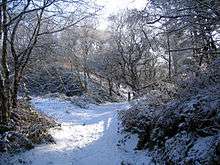
There are four large parks in Runcorn, all of which hold the Green Flag Award.[86]
- Town Park forms the centre of the eastern part of the New Town and is accessible from all of the surrounding communities. It also forms the pedestrian link to Runcorn Shopping City. Runcorn Ski Centre and Halton Miniature Railway are located in the park along with a children's play area.
- Phoenix Park adjoins Town Park to the north and includes a cafe, rock climbing wall and skate park.
- Runcorn Hill Park and Local Nature Reserve is in the centre of the western part of the town, partly on a dis-used nineteenth-century quarry. It incorporates natural woodland and heathland with more formal landscaping, playing fields, a bandstand, model boating lake, sporting facilities and cafe. A Chirotherium dinosaur footprint discovered in the quarry can be viewed in the cafe.
- Wigg Island is a large park and nature reserve to the north on the banks of the Mersey and Manchester Ship Canal. It covers 23 hectares of a former industrial site and includes several bird watching hides.
There are also several smaller local parks in the town, including Rock Park, Town Hall Park, Russell Park and Hallwood Park. Smaller nature reserves include Daresbury Firs, Dorchester Park, Murdishaw Valley, and Oxmoor Woods and Ponds.[86] There is a promenade on the banks of the Manchester Ship Canal in the old town.
There are five allotments in the town: Clifton Road, Dukesfield, Haddocks Wood, Heath Road and Oak Drive.[86]
Open areas in Runcorn form part of Mersey Forest, one of Britain's community forests.[87]
Healthcare
Runcorn's hospital is Halton General Hospital, which is administered by the Warrington & Halton Hospitals NHS Foundation Trust. Originally planned as a District General Hospital, it was never large enough to provide a full range of services. Acute medical services have been transferred to Warrington Hospital and Halton General has become a centre for non-emergency surgery and rehabilitation. Although it never had its own accident and emergency department, the hospital has an Urgent Care Centre for basic emergency care.[88] On the same site is the Cheshire and Merseyside Treatment Centre, a purpose-built hospital for orthopaedic surgery.[89]
Halton Haven Hospice is in the Murdishaw area of the town.[90] The body responsible for planning health services in Runcorn, including primary care, is the Halton Clinical Commissioning Group.[91]
Police and fire services
Cheshire Constabulary operate a police station adjacent to Runcorn Shopping City in the centre of the New Town.[92]
Cheshire Fire and Rescue Service maintains a 24 hour fire station in the town.[93]
Transport
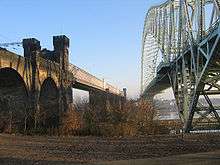
When plans for Runcorn New Town were drawn up, they included three distinct types of road: local roads, expressways and busways.[4]
The expressways form a ring road around the town in a figure of eight and are intended to keep all through traffic off the local roads.[4] This system links north to Widnes and Liverpool by the A533 over the Mersey Gateway bridge, east to Warrington by the A56, south to Northwich and north Cheshire by the A533, and west by the A557 to the M56 and to Frodsham. The M56 links to the M6 and, to the north of Widnes, the A557 links to the M62.[94]
The Busway is a system of roads for use by buses only, and bears no resemblance to guided busways or bus lanes in use elsewhere, as it is a totally separate road system, not running alongside (or down the middle of) existing roads. It was designed so that most residents would be no more than five minutes walking distance, or 500 yards (457.2 m), from a bus stop.[4] Bus services are provided by Halton Transport and Arriva North West.[95][96][97]
National Express coaches call at Runcorn,[98] and other coach services are provided by Selwyns Travel,[99] and Anthony's Travel, who are both based in the town.[100]
In addition, there is a network of dedicated cycleways in the town.[101]
There are two railway stations. Runcorn, located in the old town, is on the Liverpool branch of the West Coast Main Line, and is managed by Virgin Trains, who provide services between Liverpool Lime Street and London Euston. West Midlands Trains run a service between Liverpool and Birmingham New Street that calls at the station. Runcorn East station, located in the Murdishaw district of the new town, is managed by Transport for Wales, and provides services to Warrington, Manchester, Chester and North Wales.[102]
Runcorn is 8 miles (13 km) from Liverpool John Lennon Airport and 22 miles (35 km) from Manchester Airport.
Sports
Football
The town has two senior football teams – Runcorn Linnets FC and Runcorn Town FC. It also has a Sunday League and a Junior League. There is an open age women's team, Runcorn Ladies FC, which is affiliated to Liverpool FA and plays in the Liverpool County Women's Open Age Division.
- Runcorn Linnetts FC
Runcorn Linnets were formed as a trust-based team in 2006 from the now defunct Runcorn F.C. Halton. It has existed in various guises since 1918, and its performance peaked in 1982 when it won the Alliance Premier League, then the highest division below the Football League.[103] The club initially did not have their own ground so, up until the 2009–10 season, they took part in a groundshare with Witton Albion to play their home matches at Wincham Park, Northwich. In their first season the club gained promotion to Division 1 of the North West Counties League.[104] In October 2009 planning permission was granted for the club to build a new ground in the Murdishaw area of Runcorn.[105]
- Runcorn Town FC
Runcorn Town was formed in 1970 as Mond Rangers FC with the club changing their name in 2005 in order to "try and bring a more professional look to the club in general, and increase support from both businesses and individuals in the local community."[106] After finishing in third place in the West Cheshire League at the end of the 2009/10 season, the club were elected to join the North West Counties League at their AGM, the highest level that they have ever played at.[107]
Rugby
In the late 19th century, and prior to the 1895 schism, rugby union was played at the now defunct Runcorn RFC. Harry Collinge Speakman played during the 1888 British Lions tour to New Zealand and Australia and Samuel Houghton played for England.
When the rugby football schism occurred in 1895, Runcorn became founder members of the Northern Rugby Football Union (now Rugby Football League). Runcorn played from the 1895–96 season through to the end of 1914–15 season. They won the Lancashire League in both the 1895–96 and 1899–1900 seasons, and were losing semi-finalists in 1906–07 Rugby Football League Championship.
During the early part of the 20th century, five rugby league players from Runcorn played for both Great Britain, and England.[108][109][110][111][112] Runcorn finished bottom of the league in the 1914–15 Northern Rugby Football Union season and did not recommence playing in the aftermath of the First World War.
Rugby league in the town is now represented by Runcorn RLC. Runcorn Rugby Union FC is based at Halton Sports Club in Murdishaw.
Other sports
Runcorn Cricket Club and Runcorn Hockey Club are based at the Runcorn Sports Club in Moughland Lane.
Runcorn Rowing Club rows on the River Weaver Navigation near Clifton Village.[113]
There is an 18-hole golf course at Runcorn Golf Club in Clifton Road.[114]
Runcorn also has its own professional wrestling training-school, Runcorn Wrestling Academy, based in Grangeway.[115]
Halton Sports Club is in Murdishaw Avenue and privately run swimming pools are at Beechwood Local Centre and Stockham Lodge Raquet and Health Club. Adjacent to the latter is Runcorn Ski Centre.[116]
The local authority runs two leisure centres at Runcorn Swimming Pool and Brookvale Recreation Centre in addition to outdoor sporting facilities in its parks.[117]
Notable people
Arts and entertainment
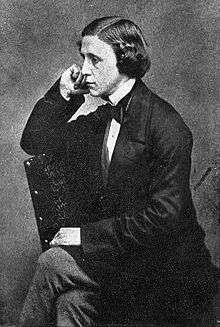
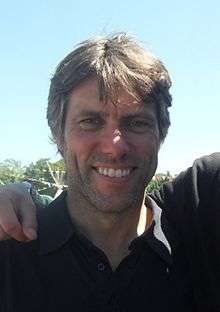
- Elizabeth Jocelin (1595 in Norton – 1622) an English writer, renowned for The Mother's Legacie to her Unborne Childe [118]
- Lewis Carroll (1832–1898), writer of Alice's Adventures in Wonderland, born at Daresbury, near Runcorn [119]
- Francis William Bourdillon (1852 at Runcorn – 1921) a British poet and translator, bibliophile and scholar [120]
- Sir Hall Caine (1853 in Runcorn – 1931), novelist and playwright [121]
- Alistair Taylor (1935 in Runcorn – 2004) assistant to Brian Epstein and General Manager of Apple Corps [122]
- Anna Keaveney (1949 in Runcorn – 2004), actress [123]
- Martin Roscoe (born 1952 in Halton) classical pianist [124]
- John Bishop (born 1966) an English comedian, presenter and actor, grew up mostly in Winsford and Runcorn [125]
- Phil Collins (born 1970 in Runcorn) an English artist and Turner prize nominee, lives in Berlin [126]
- Pete Edmunds (born c. 1972 in Runcorn) an English actor, voice actor, photographer and artist
- Kym Marsh (born 1976), singer and actress [127]
- Raymond Waring (1977), actor, grew up in Runcorn [128]
- Susan Nickson (born 1982), television writer and producer, born and raised in Runcorn [129]
- Nicola Roberts (born 1985), singer and member of girl band Girls Aloud, grew up in Runcorn [130]
Public Service & Thinking
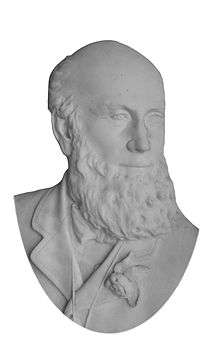
- Barony of Halton (1071-1413) comprised a succession of 15 barons. The seat of the Barons of Halton was Halton Castle
- Richard Brooke (died 1569), bought the manor of Norton from Henry VIII in 1545
- John Savage, 2nd Earl Rivers (c. 1603–1654) a wealthy English politician and royalist, lived at Halton Castle
- Sir John Chesshyre (1662 in Halton – 1738), lawyer and king's first serjeant. [131]
- Nathan Alcock (1707 in Aston –1779), physician[132]
- Thomas Alcock (1709 in Aston – 1798), Vicar of Runcorn, writer, cider maker [133]
- Thomas Hazlehurst (1816 in Runcorn – 1876), Methodist who paid for the construction of 12 chapels and three schools in the area[134]
- Sir John Rigby PC (1834 in Runcorn – 1903) a British judge and Liberal politician and MP for Wisbech 1885 to 1894
- William Allen Whitworth (1840 in Runcorn – 1905) an English mathematician and a priest in the Church of England [135]
- Thomas Alfred Jones VC, DCM (1880 in Runcorn – 1956), awarded the Victoria Cross and Distinguished Conduct Medal during WWI [136]
- Wilson Baker FRS (1900 in Runcorn – 2002) a British organic chemist
- John Riley Holt FRS (1918 in Runcorn – 2009), Professor of Experimental Physics at Liverpool University helped develop the atom bomb[137]
Sports
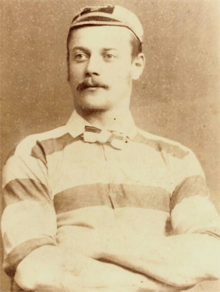
- Harry Speakman (1864 in Runcorn – 1915), rugby union player
- Samuel Houghton (1870–1920, both in Runcorn), rugby union and rugby league player, switched in 1895
- Jack Fish (1880 in Runcorn – 1940), rugby league player, 321 games, and more than 200 tries and 200 goals for Warrington Wolves
- Dick Padbury (1886 in Runcorn – date of death unknown), rugby league player
- Ernie Shaw (1894 in Runcorn – date of death unknown) rugby league footballer, 365 appearances for Wigan and St. Helens
- Robert Done (1904 in Runcorn – 1982), footballer, 290 pro appearances
- Bridget Duke-Wooley (1915 in Runcorn – 1976) a British alpine skier, competed in the 1948 Winter Olympics
- Ray Dutton (born 1945 in Runcorn), rugby league player, 398 games for Widnes Vikings
- Graham Abel (born 1960 in Runcorn), footballer, over 500 pro appearances, mainly for Chester City F.C. [138]
- Robin Reid (born 1971), boxer, lives in Runcorn [139]
- Kieron Durkan (1973–2018) footballer, 275 pro appearances, raised in Runcorn
- Mike Jackson (born 1973 in Runcorn), footballer, 560 pro appearances [140]
- Kenny Lunt (born 1979 in Runcorn), footballer, over 600 pro appearances [141]
- Lorna Webb (born 1983 in Runcorn) professional cyclist
- Scott Brown (born 1985 in Runcorn), footballer, over 300 pro appearances [142]
- Jimmy McNulty (born 1985 in Runcorn), footballer, 350 pro appearances [143]
- Shauna Coxsey MBE (born 1993 in Runcorn), professional rock climber[144]
Business & Industry
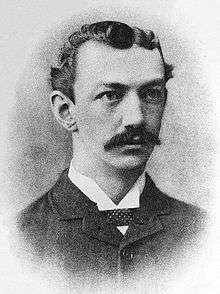
- Thomas Hazlehurst (1779–1842), founder of soap and alkali manufacturer Hazlehurst & Sons lived and died in Runcorn
- Charles Wigg (1824–1899) manufacturer of chemicals at Wigg Works, made soap and alkali, extracted copper from pyrites ash, and later making bleaching powder and ferric oxide. Wigg works closed in 1960 and the site became Wigg Island
- Hamilton Castner (1858–1899) an American industrial chemist, formed the Castner-Kellner Alkali Company in Runcorn, which operates the Castner–Kellner process
- Sir William Edward Dudley (1868 in Runcorn – 1938), president of the Co-operative Wholesale Society [145]
See also
References
Citations
- 1 2 3 4 UK Census (2011). "Local Area Report – Runcorn Built-up area (1119885014)". Nomis. Office for National Statistics. Retrieved 27 February 2018.
- ↑ "Coordinate Distance Calculator". boulter.com. Retrieved 8 March 2016.
- ↑ Halton Borough Council. "Find Us". Runcorn Hill Park. Halton Borough Council. Retrieved 28 February 2018.
- 1 2 3 4 5 Ling, Arthur (1967), Runcorn New Town Master Plan (PDF), Runcorn Development Corporation, retrieved 25 February 2018
- ↑ "Runcorn - Coat of arms (crest) of Runcorn". Heraldry of the World. Retrieved 1 March 2018.
- ↑ Nickson 1887, p. 5. and Starkey 1990, p. 4.
- ↑ Starkey 1990, pp. 1–4.
- ↑ Nickson 1887, pp. 6–13. The foundations of the fort were discovered during the building of the railway bridge but were covered by an abutment of the bridge.
- ↑ Starkey 1990, pp. 7–8.
- ↑ Greene 1989, pp. 1–9.
- ↑ Greene 1989, p. 151. and Nickson 1887, p. 39.
- ↑ Historic England, "Remains of Rock Savage (1330365)", National Heritage List for England, retrieved 4 April 2015
- ↑ Starkey 1990, pp. 57–58.
- ↑ King, Daniel, The Vale Royal of England, 1656 (quoted in Starkey 1990, p. 73.).
- ↑ Starkey 1983, pp. 19–24. and Starkey 1990, pp. 125–130.
- ↑ Starkey 1990, p. 173.
- ↑ Starkey 1990, pp. 133–137.
- ↑ Vardy, Peter I. (2006). "Thomas Hazlehurst and his family: Methodism and the Early Chemical Industry in Runcorn in the Nineteenth Century". Cheshire History. 45: 67–82. ISSN 0141-8696.
- ↑ Nickson 1887, p. 206.
- ↑ Starkey 1990, pp. 160–162.
- ↑ Starkey 1983, p. 184.
- ↑ Thompson 2000, p. 17.
- 1 2 3 Halton Business Directory, Halton Borough Council, archived from the original on 22 August 2007, retrieved 1 September 2007
- ↑ Runcorn UD: Total Population, A Vision of Britain through Time, retrieved 16 October 2012
- ↑ Unhappy customers, BD: The Architects' Website, 30 March 2007, archived from the original on 28 September 2007, retrieved 27 July 2007
- ↑ Phillips and Phillips 2002, p. 27.
- ↑ Phillips and Phillips 2002, p. 9.
- ↑ Starkey 1990, p. 193.
- ↑ Phillips and Phillips 2002, p. 11.
- ↑ The Borough of Halton, Halton Borough Council, archived from the original on 22 September 2008, retrieved 23 June 2013
- ↑ Your Councillors, Halton Borough Council, retrieved 23 June 2013
- ↑ Councillors, democracy and elections, Halton Borough Council, archived from the original on 14 June 2013, retrieved 23 June 2013
- ↑ Phillips and Phillips 2002, p. 100.
- ↑ Phillips and Phillips 2002, pp. 102–103.
- ↑ Starkey 1990, p. 221..
- ↑ "Lord Carlisle of Bucklow", The Daily Telegraph, 19 July 2005, retrieved 23 June 2013
- ↑ Derek Twigg, UK Parliament, retrieved 23 June 2013
- ↑ Runcorn New Town, Halton Borough Council, archived from the original on 16 February 2007, retrieved 28 June 2007
- ↑ Liverpool, St Helens, Widnes & Runcorn:Explorer 275 map, Ordnance Survey.
- ↑ Phillips and Phillips 2002, pp. 4–5.
- ↑ Population statistics, Halton Borough Council, archived from the original on 22 May 2012, retrieved 23 June 2013
- ↑ Population breakdown of Halton from the Census 2011, Halton Borough Council, archived from the original on 22 May 2012, retrieved 4 November 2012
- ↑ Halton UA: Total Population, A Vision of Britain through Time, retrieved 7 April 2007
- ↑ "2011 Census Halton key statistics profile" (PDF). Halton Borough Council. Retrieved 23 June 2018.
- ↑ "Chester Diocese:Frodsham Deanery". The Church of England: Diocese of Chester. Archived from the original on 3 February 2007. Retrieved 2 April 2007.
- 1 2 3 4 5 "Churches in Runcorn". Halton Borough Council. Archived from the original on 30 September 2007. Retrieved 2 April 2007.
- ↑ The Diocese of Shrewsbury, The Roman Catholic Diocese of Shrewsbury, retrieved 23 June 2018
- ↑ Home, Wat Phra Singh UK, retrieved January 3, 2017
- ↑ "ICI says goodbye to Chlor-Chemicals". The Engineer. 5 December 2000. Retrieved 30 August 2011.
- ↑ INEOS Businesses, INEOS Group, archived from the original on 12 March 2007, retrieved 29 March 2007
- ↑ the heath ... the best place for your business, The Heath Business and Technical Park, archived from the original on 3 May 2007, retrieved 29 March 2007
- ↑ Halton Borough Council. "This is Halton: An Essential Guide to Living and Working in Halton" (PDF). Runcorn and Widnes - Make Halton Your Business. Retrieved 27 February 2018.
- ↑ Peel Ports Group, Peel Ports Group, retrieved 18 August 2008
- ↑ Eddie Stobart joining Stock Market, Eddie Stobart, 15 August 2007, archived from the original on 12 August 2009, retrieved 18 August 2008
- ↑ Short, Adrian (23 August 2007), "Truck giant to haul in jobs", Runcorn Weekly News, Trinity Mirror North West & North Wales, retrieved 18 August 2008
- ↑ Clay, Oliver (13 March 2014), "Incinerator switch on", Runcorn Weekly News, Trinity Mirror Cheshire, p. 3
- ↑ Halton Unitary in Figures, Halton Borough Council, archived from the original on 2 July 2007, retrieved 4 April 2007
- ↑ Regional Gross Value Added (PDF), Office for National Statistics, 21 December 2005, p. 242, archived from the original (PDF) on 26 February 2007, retrieved 7 April 2007
- ↑ Town centres, Halton Borough Council, archived from the original on 13 May 2007, retrieved 28 June 2007
- ↑ Halton Lea, Halton Borough Council, archived from the original on 16 February 2007, retrieved 28 June 2007
- ↑ The Halton Castle Website, The Norton Priory Museum Trust, archived from the original on 1 September 2007, retrieved 27 March 2007
- ↑ Bullock, Ross (7 February 2005), History of Norton Priory and Runcorn, archived from the original on 11 October 2007, retrieved 27 March 2007 This is a personal website but it is accurate and comprehensive.
- ↑ Norton Priory Museum & Gardens, The Norton Priory Museum Trust, retrieved 27 March 2007
- ↑ Starkey 1990, p. 162.
- ↑ Historic England, "Church of All Saints, Runcorn (1104888)", National Heritage List for England, retrieved 14 September 2013
- ↑ Listed Buildings in Halton (pdf), Halton Borough Council, retrieved 23 June 2013
- ↑ Starkey 1990, p. 218.
- ↑ "Halton Miniature Railway". Halton Miniature Railway. Retrieved 10 March 2018.
- ↑ Ling, Arthur (1967), Runcorn New Town Master Plan (PDF), Runcorn Development Corporation, retrieved 25 February 2018
- ↑ "Runcorn Ski Centre". Runcorn Ski Centre. Retrieved 10 March 2018.
- 1 2 Background, The Brindley, retrieved 23 June 2013
- ↑ Facilities, The Brindley, archived from the original on 29 May 2013, retrieved 23 June 2013
- ↑ Cineworld: Runcorn, Cineworld Cinemas, archived from the original on 24 October 2007, retrieved 28 June 2007
- ↑ Mersey Beat (2001–2004), IMDb, retrieved 23 June 2013
- ↑ Two Pints of Lager & a Packet of Crisps, BBC, retrieved 30 March 2007 2007
- ↑ Drop Dead Gorgeous, BBC, archived from the original on 15 March 2007, retrieved 30 March 2007
- ↑ Venue Hire, Norton Priory, archived from the original on 2 August 2013, retrieved 23 June 2013
- ↑ Runcorn & Widnes Weekly News, Trinity Mirror North West & North Wales, retrieved 9 April 2009
- ↑ Runcorn & Widnes World, Newsquest Media Group, retrieved 9 April 2009
- ↑ About HCR 92.3Fm, Halton Community Radio, archived from the original on 30 May 2013
- ↑ Glynn, Paul (6 November 2008). "Station tunes in for relaunch". Runcorn Weekly News. Trinity Mirror North West & North Wales. Retrieved 9 April 2009.
- ↑ Starkey 1990, pp. 10–11..
- ↑ The Runcorn Ferry, monologues.co.uk, archived from the original on 17 May 2014
- ↑ "Library Opening Hours". Halton Borough Council. Retrieved 1 March 2018.
- ↑ "Contact Us". Halton Borough Council. Retrieved 1 March 2018.
- 1 2 3 "Parks and Allotments". Halton Borough Council. Retrieved 1 March 2018.
- ↑ "What is The Mersey Forest?". The Mersey Forest. Retrieved 1 March 2018.
- ↑ "Halton General Hospital". Warrington and Halton Hospitals NHS Foundation Trust. Retrieved 1 March 2018.
- ↑ "Cheshire and Merseyside Treatment Centre". Warrington and Halton Hospitals NHS Foundation Trust. Retrieved 1 March 2018.
- ↑ "Halton Haven Hospice". Halton Haven Hospice. Retrieved 1 March 2018.
- ↑ "Halton CCG Home". Halton Clinical Commissioning Group. Retrieved 1 March 2018.
- ↑ "Runcorn Police Station - Cheshire Police". Cheshire Constabulary. Retrieved 23 June 2018.
- ↑ "Runcorn Fire Station". Cheshire Fire and Rescue Service. Retrieved 23 June 2018.
- ↑ Landranger 108, 109 and 117 maps, Ordnance Survey
- ↑ Public transport, Halton Borough Council, archived from the original on 29 August 2013, retrieved 23 June 2013
- ↑ Welcome, Halton Transport, retrieved 23 June 2013
- ↑ Timetables and tickets, Arriva, retrieved 23 June 2013
- ↑ National Express Coach from Runcorn, National Express, retrieved 23 June 2013
- ↑ Coach hire Liverpool, Manchester, Merseyside, the Wirral and Cheshire, Selwyns Travel Ltd, retrieved 23 June 2013
- ↑ Anthony's Travel, Anthony's Travel, retrieved 28 June 2007
- ↑ "Cycling and walking". Halton Borough Council. Retrieved 23 June 2018.
- ↑ Trains - information and advice, Halton Borough Council, archived from the original on 30 August 2013, retrieved 23 June 2013
- ↑ A History of Runcorn AFC/Runcorn FC Halton, Runcorn Linnets FC, retrieved 25 July 2010
- ↑ A History of Runcorn Linnets FC, Runcorn Linnets FC, retrieved 25 July 2010
- ↑ Bettley, Dave (13 October 2009), "Runcorn Linnets: Halton Borough Council grant planning permission for new UniBond League standard ground at Halton Sports in Murdishaw", Runcorn Weekly News, icCheshireOnline, retrieved 15 October 2009
- ↑ Runcorn Town FC Official Website – Club History, Runcorn Town FC, retrieved 27 October 2010
- ↑ Bergin, Dave (24 June 2010), "Football: Runcorn Town accepted into Vodkat League", Runcorn Weekly News, icCheshireOnline, retrieved 27 October 2010
- ↑ England International Stats: Butterworth, RFL, retrieved 18 December 2013
- ↑ England International Stats: Jim Jolley, RFL, retrieved 18 December 2013
- ↑ England International Stats: A. Kennedy, RFL, retrieved 18 December 2013
- ↑ England International Stats: Dick Padbury, RFL, retrieved 18 December 2013
- ↑ England International Stats: S. Walker, RFL, retrieved 18 December 2013
- ↑ Runcorn Rowing Club, Runcorn Rowing Club, retrieved 29 March 2007
- ↑ Runcorn Golf Club, English Golf Courses, retrieved 25 April 2007
- ↑ Runcorn Wrestling Academy, Runcorn Wrestling Academy, archived from the original on 22 July 2010, retrieved 9 August 2010
- ↑ Runcorn Ski Centre, Runcorn Ski Centre, retrieved 29 March 2007
- ↑ Sports in Halton, Halton Borough Council, archived from the original on 13 April 2007, retrieved 29 March 2007
- ↑ Dictionary of National Biography, 1885-1900, Volume 29, Jocelin, Elizabeth retrieved 26th July 2018
- ↑ IMDb Database retrieved 26th July 2018
- ↑ Francis William Bourdillon, PoemHunter.com, retrieved 4 May 2016
- ↑ Allen, Vivien (1997) Hall Caine: Portrait of a Victorian Romancer, Sheffield Academic Press, ISBN 1-85075-809-3
- ↑ IMDb Database retrieved 26th July 2018
- ↑ IMDb Database retrieved 26th July 2018
- ↑ Morrison, Bryce. "Martin Roscoe". In Deane L. Root. Grove Music Online. Oxford Music Online. Oxford University Press. (subscription required)
- ↑ Jamieson, Teddy (20 July 2010), "The rise and rise of comic John Bishop", Herald Scotland, Herald and Times Group, archived from the original on 13 February 2012, retrieved 22 February 2011
- ↑ Art in America, by Kerry Gaertner Gerbracht, 2013 retrieved 26th July 2018
- ↑ "Ex Hear'Say star's passion for Runcorn", Runcorn Weekly News, icCheshireOnline, 27 April 2006, archived from the original on 13 April 2009, retrieved 12 November 2006
- ↑ Raymond Waring, International Movie Database, retrieved 14 September 2013
- ↑ Two Pints of Lager And a Packet of Crisps, BBC, retrieved 6 April 2009
- ↑ About Nicola, Nicola Roberts [dot net], archived from the original on 30 April 2007, retrieved 23 April 2007
- ↑ Lemmings, David (2004) 'Chesshyre, Sir John (1662–1738)', Oxford Dictionary of National Biography, Oxford University Press, online edn . Retrieved 7 March 2007
- ↑ Moore, Norman (2004) ‘Alcock, Nathan (1709–1779)', rev. Caroline Overy, Oxford Dictionary of National Biography, Oxford University Press, online edn. . Retrieved 1 March 2007
- ↑ Woodland, Patrick (2004) ‘Alcock, Thomas (1709–1798)', Oxford Dictionary of National Biography, Oxford University Press, online edn, . Retrieved 1 March 2007
- ↑ Vardy, P. I. (2005–2006) 'Thomas Hazlehurst and his family', Cheshire History, 45.
- ↑ Dictionary of National Biography, 1912 supplement, Whitworth, William Allen retrieved 26th July 2018
- ↑ Thompson, Dave (2002) I Laughed Like Blazes: The Life of Private Thomas 'Todger' Jones, VC, DCM Dave Thompson.
- ↑ Bremner, Charles; Robertson, David (9 March 2009), Professor John Holt: experimental physicist, Times Newspapers, retrieved 3 April 2009
- ↑ SoccerBase Database retrieved 26th July 2018
- ↑ BoxRec.com; Robin Reid retrieved 26th July 2018
- ↑ SoccerBase Database retrieved 26th July 2018
- ↑ SoccerBase Database retrieved 26th July 2018
- ↑ SoccerBase Database retrieved 26th July 2018
- ↑ SoccerBase Database retrieved 26th July 2018
- ↑ Runcorn rock-climber second best on the planet after winning silver at Bouldering World Cup
- ↑ Purvis, Martin (2004), "Dudley, Sir William Edward (1868–1938)", Oxford Dictionary of National Biography, Oxford University Press, retrieved 13 July 2015 ((subscription or UK public library membership required))
Sources
- Greene, J. Patrick (1989), Norton Priory: The archaeology of a medieval religious house, Cambridge: Cambridge University Press, ISBN 0-521-33054-8
- Nickson, Charles (1887), History of Runcorn, London and Warrington: Mackie & Co., OCLC 5389146
- Phillips, A.D.M.; Phillips, C.B. (2002), A New Historical Atlas of Cheshire, Chester: Cheshire County Council, ISBN 0-904532-46-1
- Starkey, H.F. (1983), Schooner Port: Two Centuries of Upper Mersey Sail, Ormskirk: G.W. & A. Hesketh, ISBN 0-905777-34-4
- Starkey, H.F. (1990), Old Runcorn, Halton Borough Council
- Thompson, Dave (2000), Bridging the Years: The Story of Runcorn-Widnes Transporter Bridge, Runcorn: Dave Thompson
Further reading
- Cowan, C.A. (1990), Runcorn Ferry and Hale Ford, Crossing the Runcorn Gap, Halton Borough Council
- Cowan, C.A. (1990), Runcorn Railway Bridge, Crossing the Runcorn Gap, Halton Borough Council
- Cowan, C.A. (1990), Runcorn Town Hall: A History and Description, Halton Borough Council
- Cowan, C.A. (1992), Early Bridging Proposals, Crossing the Runcorn Gap, Halton Borough Council
- Halton Borough Council (1978), The Bridging of Runcorn Gap, Halton Borough Council
- Howard, Liz. (1993), The Way We Were – Runcorn Remembered: A Social History, Manchester: Aurora, ISBN 1-85926-031-4
- Howard, Liz. (1995), Runcorn in Old Picture Postcards, Back in Time, Zaltbommel: European Library, ISBN 90-288-6124-6
- Nicolle, Dorothy (2004), Widnes and Runcorn: Photographic Memories, Salisbury: Frith Book Company, ISBN 1-85937-854-4
- Starkey, H.F. (1980), Runcorn in Times Past, Chorley: Countryside Publications, ISBN 0-86157-032-4
- Starkey, H.F. (1994), Runcorn, The Old Photographs Series, Bath: Alan Sutton, ISBN 0-7524-0025-8
- Starkey, H.F. (1999), Runcorn – The Second Selection, Images of England, Stroud: Tempus, ISBN 0-7524-1826-2
- Starkey, H.F. (2005), Runcorn: A Century of Change, Images of England, Stroud: Tempus, ISBN 0-7524-3617-1
- Starkey, H.F. (2008), Runcorn: A Town not so New, Gwespyr, Flintshire: MiddleView, ISBN 978-1-902964-08-9
- Thompson, Dave (2000), Over the Hill: An Historical Look at Runcorn Hill and its Locality, Runcorn: Dave Thompson
- Thompson, Dave (2000), Bridging the Mersey: A Pictorial History, Back in Time, Zaltbommel: European Library, ISBN 90-288-2640-8
- Thompson, Dave (2001), Bridging Us Together: The Story of Runcorn–Widnes Bridge, Runcorn: Dave Thompson
- Thompson, Dave (2004), The Changing Face of Runcorn, Britain in Old Photographs, Stroud: Sutton, ISBN 0-7509-3507-3
- Whimperley, Arthur (1981), Halton Castle: An Introduction and Visitors' Handbook, Widnes: Arthur Whimperley
- Whimperley, Arthur (1986), The Barons of Halton, Widnes: MailBook Publishing
External links
| Wikimedia Commons has media related to Runcorn. |
| Wikivoyage has a travel guide for Runcorn. |
| Wikisource has the text of the 1911 Encyclopædia Britannica article Runcorn. |
